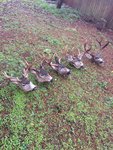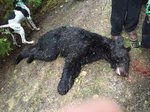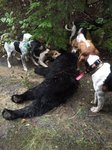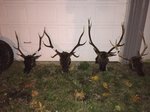




Packs of hound dogs viciously ripping apart black bears. Aggressively poached cougars and bobcats. Heads lopped off of deer and elk along popular hiking trails and their bodies left behind to rot.
These are just some of the accusations resulting from a multiple year investigation utilizing wildlife enforcement agents in two states that has identified an unprecedented suspected poaching ring based out of Cowlitz County.
Wildlife officials say the poachers have illegally killed hundreds of animals, including deer, elk, bear, cougar and bobcats. The investigation began two years ago when wildlife officials in Oregon began finding the bodies of buck deer along popular trails, their heads cut off and taken presumably as trophies.
Hidden trail cameras were set up in those areas, and last December law enforcement officials were finally able to catch two of the perpetrators in the act of poaching.
Using information gleaned from that preliminary sleuthing, officials wound up serving warrants in Cowlitz County that opened up a twisted treasure trove of evidence into the group’s grisly world of poaching and wasting wild animals.
“We’re digging through the evidence and trying to capture it all in a way so that someone can digest this massive amount of information that we’re going to be presenting,” said Mike Cenci, deputy chief of westside enforcement operations for the Washington Department Fish and Wildlife. Cenci admitted to playing coy about the exact location of some of the known poaching scenes at this point in the investigation, but at least one case is known to have happened as far away as The Dalles, Oregon.
“It’s safe to say Southwest Washington,” said Cenci. “I don’t want to inadvertently leave a county out, but we know where the lion's share of the poaching happened.”
Censi says that poaching is a problem that he and his department are well aware of but that this particular case is notable for the complexity, ruthlessness and persistent longevity of the operation. Despite his obvious disdain for the illegal hunting, he says that trying to stop all poaching activities is, unfortunately, a fool’s errand.
“Certainly the closed season take of big game animals is something that happens 365 days a year, and the primary species involved would be bear, deer, elk, cougar and bobcat,” said Cenci, who noted that many of the illegal killings are perpetrated under the cover of darkness and with the illegal aid of high-powered spotlights that blind the animals.
“We do use decoys, but some of the poachers have become decoy shy. They’re no different than a smart mallard. Late in the poaching season they become wise.”
According to Cenci, the biggest challenge facing his department is a critical lack of staffing. He says it’s hard to justify sending resources blindly into the wide open woods in order to find a few secluded individuals when there are others who can be more effectively policed.
“You look at Long Beach clam digging. We had 18,000 people on the beach on Saturday. If you’re going to police that you’re going to leave a hole somewhere else,” said Cenci. “You can only stretch your same staff so far. You work all day, do you have the energy to work all night? Do you police the razor clam fishery, or do you go out in the woods to look for someone running hounds illegally?”
Cenci says that personnel and budget cuts coupled with the intricate nature of the sprawling terrain the WDFW enforcement program is tasked with covering has made for a nearly impossible task he put on par with retrieving the proverbial needle from a haystack
“It’s really tough to patrol such a vast geography, especially with the staff that we have,” lamented Cenci. “We make some really, really hard choices regarding what we're going to do on any give day.”
Although more poaching and illegal hunting citations are written during actual hunting seasons, Cenci is uncertain if those law-based distinctions have much impact on the overall poaching effort.
“We know that some people use a regulated season as cover. We also tend to throw more weight at a regulated season. So as you get closer to the deer season we know that somebody might illegally start early,” said Cenci. “I don't know if the activity is greater then, but our activity certainly is more focused.”
The way Cenci sees it, there are distinct types of natural resource violators, and the poaching ring discovered in Cowlitz County represents the worst of the worst.
“There’s three categories of violators in my view. There’s the fellow that makes a mistake and they are legitimately confused. Our guidelines can be complex and they stub their toe. That’s often times warning territory for us.
“Then you have the opportunist. Let’s say you hunted for three days hard but you got nothing, and then you’re coming out of the woods and here's a deer just after shooting hours. It’s a legal buck and somebody’s ethics falter and they kill that deer. To me that’s more of an opportunist,” explained Cenci.
“And then you have the hardcore violators. I think that’s the smallest percentage of our violators. I can’t back that up statistically but that’s my feeling. We have to determine how much energy we’re going to spend trying to find that hardcore guy, which is much more difficult to find, rather than that opportunist who might be shied away by using deterrents, like decoys.With these hardcore guys there’s no deterrents. Maybe prison.”
Cenci said that the Cowlitz County poaching ring is from that hardcore contingent because they seemed to be killing simply for the sake of killing while wantonly wasting the meat of the animals. Oftentimes the heads or racks were the only things taken. Other times nothing was salvaged from the poached animal at all and it was simply left to rot.
On one video obtained by officials, a suspect can be heard bragging about killing four bears in one day while a pack of hunting hounds tears at one freshly poached bear carcass.
“I’ve got relationships with people who have cheated in the outdoors, maybe opportunists, maybe borderline hardcore, but there was always a respect for the animals. This is a complete disregard for the animals,” said Cenci.
That type of behavior is something that the WDFW has been alarmed to document with increasing frequency in recent years.
“One of the things we are seeing is an increase in, for whatever reason, people going out and whacking animals and leaving the carcass in the field. What the hell? In my mind, and I’ve got a small brain, but to me that person just wanted to kill something. No respect for the law for sure but even worse, no respect for the animal.”
Cenci is trying hard not to let his frustration blind him to the valid intentions of the majority of folks who head out into the wildlands of Washington.
“I think most people are generally good, but they’re also human and so from time to time temptation gets in the way and someone violates a natural resource law,” said Cenci. “We’d prefer to catch every hardcore guy. They certainly do the most damage individually. Collectively? Statistically? Who knows.”
Cenci says that the unfettered use of hound dogs by members of the poaching ring was a particularly disturbing aspect uncovered during the investigation. Using hounds to hunt bear, bobcat, cougar or lynx is illegal in Washington and Oregon, and the sheer savagery of the behavior has been unsettling to many who have seen the footage that was obtained from cell phones of the accused. Censi is unsure of exactly how common the illegal use of hunting hounds is, but he’s smart enough to know it’s still happening somewhere.
“I think far more of this is happening than we’ve been aware of, but you don’t know if you don’t go. Again, there’s a lot of landscape out there and you know these guys obviously have killed a lot of animals right underneath our noses,” said Cenci.
“Our officers were pretty frustrated when they saw some of the areas where the poaching occurred and they thought they had somehow failed the public. In reality we failed them. We need more of a presence. You just can’t do it all unless you want to sleep out in the woods 24/7.”
Even if an officer is present to observe a potential offender in the field, Cenci says, it can be difficult to make a surefire case unless the individual is actively observed committing a crime.
“You can walk around in the woods all day long with a gun. That’s not illegal no matter the season,” said Cenci, who added that a truck full of dogs out in the woods does not constitute illegal behavior either.
“If I contact that person too soon they might just say they’re dog was getting some air. If he tells me to pound sand and doesn’t admit to anything and just tells me he was taking his dogs for some exercise, there is no ban on taking dogs into the woods. It’s just on using them on specific animals.”